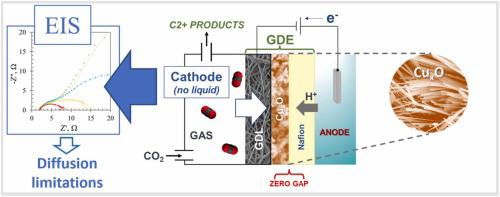Applied Catalysis B: Environment and Energy ( IF 20.2 ) Pub Date : 2022-08-17 , DOI: 10.1016/j.apcatb.2022.121845 Daniele Giusi , Matteo Miceli , Chiara Genovese , Gabriele Centi , Siglinda Perathoner , Claudio Ampelli

|
Copper oxide-based gas-diffusion electrodes (CuxO/GDEs) for CO2 electrocatalytic reduction are investigated in presence and absence of liquid electrolyte (liquid- and gas-phase operations) in terms of (i) catalytic reactivity in compact-design flow cells (with the electrodes located on the two sides of a Nafion membrane) and (ii) in situ electrochemical characterization by electrochemical impedance spectroscopy (EIS), cyclic voltammetry (CV) and chronoamperometry (CA). On the same electrocatalyst, the adoption of liquid- or gas-phase operations induces significant changes in the catalytic behaviour with formation of C2+ chemicals observed only in gas-phase. Parallel tests by EIS, complemented by CV and CA measurements, evidence that the catalytic properties of these electrodes, and in turn the selectivity paths, are largely determined by transport limitations rather than only by the intrinsic properties of the electrocatalysts. The EIS technique, used here for the first time to compare liquid- and gas-phase operations, has proved to be a strategic tool, providing insights into the critical factors needed to optimize performance beyond the properties of the electrocatalysts themselves.
中文翻译:

基于 CuxO 的气体扩散电极 (GDE) 在存在和不存在液体电解质的情况下用于 CO2 电催化还原的原位电化学表征以及与 C2+ 产物形成的关系
用于 CO 2的氧化铜基气体扩散电极 (Cu x O/GDE)在存在和不存在液体电解质(液相和气相操作)的情况下研究电催化还原的(i)紧凑型流动电池(电极位于 Nafion 膜的两侧)中的催化反应性和( ii) 通过电化学阻抗谱 (EIS)、循环伏安法 (CV) 和计时电流法 (CA) 进行原位电化学表征。在同一电催化剂上,采用液相或气相操作会导致催化行为发生显着变化,仅在气相中观察到 C2+ 化学物质的形成。EIS 的平行测试,辅以 CV 和 CA 测量,证明了这些电极的催化性能,进而证明了选择性路径,主要取决于传输限制,而不仅仅是电催化剂的固有特性。EIS 技术在这里首次用于比较液相和气相操作,已被证明是一种战略工具,可以深入了解优化电催化剂本身性能之外的性能所需的关键因素。











































 京公网安备 11010802027423号
京公网安备 11010802027423号